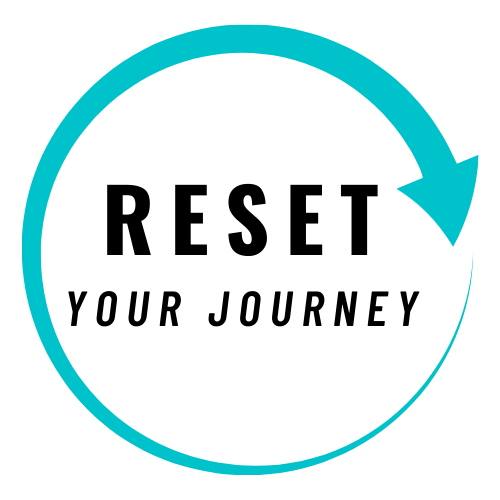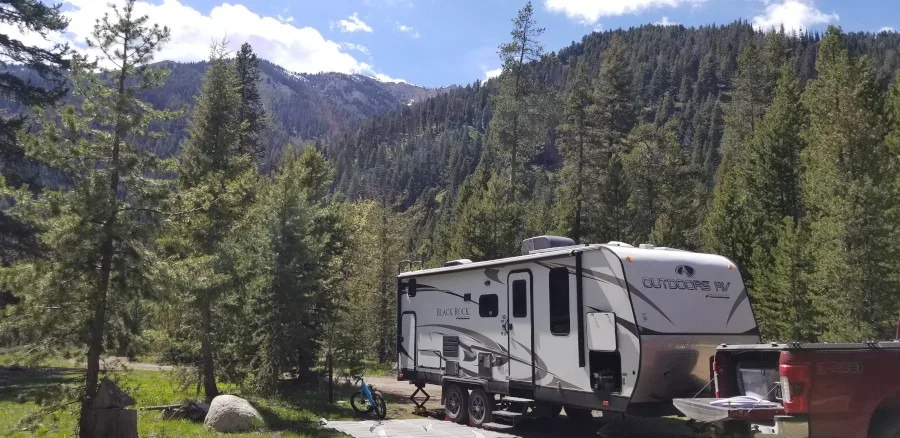Last Updated on 05/21/2024 by Glynn Willard
Best Travel Trailer To Live In
We believe Outdoors RV is the best 4-season travel trailer for full-time living. Read on to learn why…
What were we looking for the first time when we started shopping for the best RV to live in full-time?
We had already narrowed it down to towable RVs (not fifth wheels), but which one?
Many start with a floor plan or a brand they’ve heard of before.
We had a different agenda.
We needed to save money, so planned on boondocking the majority of the time.
Therefore, we needed something suited for all of the aspects of boondocking in both hot and cold weather.
We were going to be full-time RVers, so we needed a great trailer with tons of storage, bunk beds, and a private master bedroom.
We needed the best high-quality boondocking travel trailer on the market at the time to stay on public lands near National Parks!
The plan was to buy a used RV, so we didn’t want a brand with a squeaky floor and leaks.
There will be opinions, so this meant the best boondocking travel trailer for us and that was affordable and superior to the industry standard.
I had a checklist of standard features during my lengthy research and shopping for recreational vehicles:
- High quality and built like a tank.
- Well insulated.
- High ground clearance.
- A high capacity fresh water tank.
- Enough interior space to live and work in.
- A full bathroom with a standard bathroom door.
- The ability to carry a lot of weight (high GVWR).
- Enough solar power and batteries to boondock.
- A great amount of storage space.
- A private bedroom (for obvious reasons).
- We were hoping to find all of the above attributes in a bunk house model
I knew this would come at a higher price, but to get the above important options and avoid different issues, it’s worth the price difference.
Don’t feel like reading? Listen to the audio version of this blog.
Outdoors RV Mountain Series Reviews
ORV offers a wide range of sizes with slightly different floor plans, all are a great choice with all the features/reasons listed below.
They’re very reliable trailers.
First and foremost: A quality RV
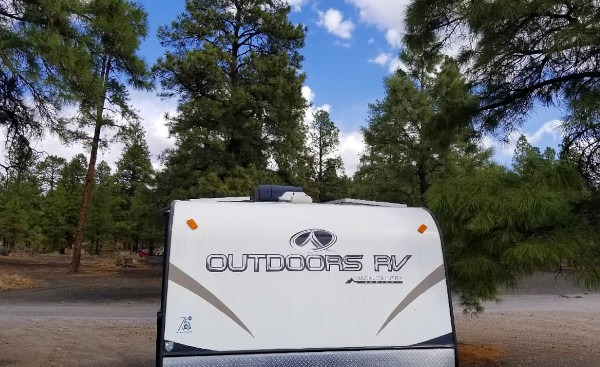
There are an awful lot of RV assemblers on the market. And many on the market today are not built very well.
But if you think about it, why should travel trailer manufacturers build well?
Most RV’s are taken out for RV adventures two to four times a year by the average owner.
And they’re usually used in temperate climates. You’re all too familiar with the “chasing 70 degrees” concept.
So if I’m building an RV, I need to hit a price point that meets the economic demand of most consumers.
Outdoors RV does not fall into that category.
Their company focus is different. ORVs are built for and marketed to a different kind of consumer with unique needs and a love for the great outdoors.
So, what’s the difference? Let’s look at our experience with each of the criteria below.
Second: Insulation
As far as I’m concerned, it doesn’t matter what climate you’re camping in with your camper.
The better the insulation, the less resources used to heat and cool your rig regardless whether it’s a smaller RV or a large RV. Period.
We spend a lot of time both in the desert and the mountains and it’s easy to keep the rig comfortable.
Our personal preference is to stay in hotter and colder environments anyway.
This is the best way to have leaner crowds and more boondocking locations to choose from.
Outdoors RV super insulates (for a camper) all aspects of their rigs.
The doors, walls, roof and underbelly. This makes an enormous difference for full time living (in an ORV)!
We also have very little condensation build up inside under all circumstances.
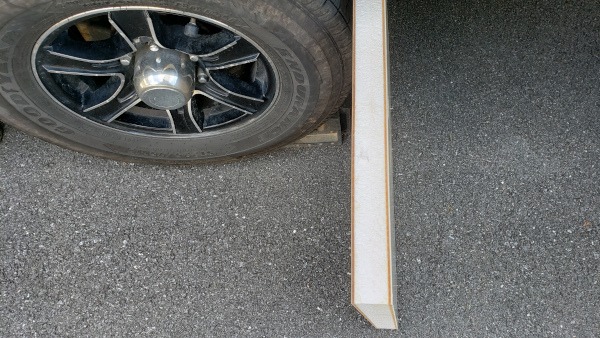
A cut out of ORV’s insulated walls.
Third: Ground clearance
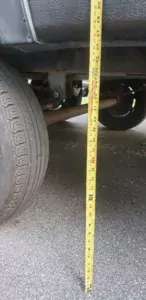
Ground clearance for a travel trailer… who would have thought to consider this before the explosion of Overlanding trailers?
But it’s a good idea and it makes a real difference.
And that includes a good suspension system.
Boondocking can take you on some really bumpy roads leading to that picturesque mountain valley.
And without a good suspension system and ground clearance, even a good travel trailer will get beaten up.
Outdoors RV uses the MORryde CRE 3000 and AllTrek 4000 system, which is a great option.
I can attribute that it works great and does what it should.
We pushed it beyond its limits and replaced it when it was due.
I learned the hard way that you have to lube your wet bolts on the suspension system. Make a not of that for you RV travels.
You can read about the whole process in our article, Uneven Tire Wear On Your Travel Trailer? It’s Not What We Expected.
Fourth: Large fresh water tank
Water is the primary limiting factor when boondocking. Not power. So, the larger the fresh water capacity, the better.
Boondocking with a travel trailer makes it easy to come and go without losing your spot. Which also means you can bring water back to your trailer as needed.
But it’s a lot easier if you just start with a large-capacity freshwater tank. Our ORV holds 80 gallons of fresh water, plus 10 gallons in the hot water heater.
I keep an additional 15 gallons in the truck bed.
That buys us almost ten days without refilling. I would like to have 100 gallons in the trailer.
On a side note, each new model comes with a 100-gallon freshwater tank.
Large freshwater tanks seem to be the standard on modern high end travel trailers.
Fifth: A relatively high GVWR
Loading your rig with everything you need to live the full-time RV life can add a lot of weight.
This is not applicable if you’re not full-timing in your trailer unless you pack everything but the kitchen sink.
A trailer’s gross vehicle weight rating (GVWR) is often overlooked when shopping for the perfect trailer to live in full-time.
That can be a serious mistake. Tire blowouts are generally due to overweighting a tire.
Yes, junk tires and under-inflated tires also contribute to tire blowouts. But too much weight in your rig is a real problem.
If you need an extra high cargo-carrying capacity, consider an Outdoor RV 5th wheel (Outdoors RV Glacier Peak) or one of their toy haulers (trail Series).
Just make sure you have the right tow vehicle that can handle the additional tongue weight.
You can achieve a much higher GVWR with a toy hauler, which might be a better idea. Especially an all-aluminum trailer like ATC.
Again, make sure you have a towing vehicle that can handle the tongue weight.
All of that said, Outdoors RV has an impressive cargo-carrying capacity overall!
A way to have self-sufficient power
I wanted a rig with at least enough battery power for two days when used efficiently.
I didn’t have any fantasies about running the AC off the batteries (that would be amazing though).
I knew we would rely on generators for things like the AC and microwave.
But enough solar (we have 340 watts) and batteries to run the water pump, LED lights, and assist with the propane refrigerator.
We have two 109 amp hour deep cycle wet batteries. That gives us a hair over 100 amp hours of usable electricity.
Nothing to brag about! But it works well and costs very little and maintains our “tiny house” just fine.
In our experience, we run the generators twice a day while boondocking for the microwave. If we need AC or heat, we’re running the generators.
Can we get by without a microwave or AC? For sure, but I default to Rose’s comfort. My life is better that way!
Lastly: A bunk house model
Since we have two kids, a bunkhouse suited us. The last thing we wanted to do was break down a dinette every evening at bedtime.
Besides, from the perspective of a child, having easy access to your own space is important.
What kid wouldn’t want a cool cave to call their own anyway?!
So, when we looked at all of the “needs and wants,” Outdoors RV satisfied all of them perfectly.
That’s what we hunted for and finally found 400 miles away. It was worth the effort!
Our Expectations When We Bought The ORV Trailer
Honestly, I expected a solid-built tank. And that’s just what I got!
I had heard owners of lesser brands have horror stories of problem online from full-time families about constant repairs for different manufacturers.
So, my expectations were slightly lower than they should have been.
But fortunately, we didn’t experience anything like we’d heard. Our 23BKS has held up like a champ!
It was the perfect choice!
The 23BKS Black Rock was the precursor to the Outdoors Black Stone Mountain Series and Backcountry Series.
How The ORV Held Up To Full-Time Living.
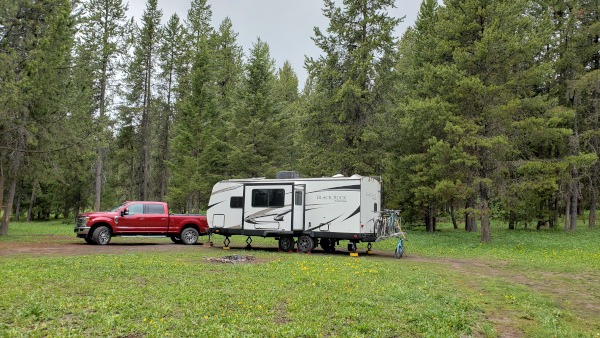
Honestly, we beat up on our rig and it simply asked for more. And then said, “Is that all you got?”
Week after week, we pulled it over some nasty terrain and it didn’t flinch! It’s even rugged snow ready!
So far as the writing of this article, sixteen thousand miles and it’s still in great condition after rough terrain.
It’s in such great shape that we decided to push it another time around the country after some standard maintenance.
I have a feeling it won’t flinch.
Update: It didn’t flinch. After over 35k miles, the quality of our unit still held up like a champ!
We eventually sold our ORV to give the camper van life a try for a short chapter in our life.
The bottom line, our 2017 Outdoors RV 23BKS Black Rock was better than we expected.
What Do We Wish Our ORV Had?
The only three things I wish our Black Rock ORV came with are:
- A larger freshwater tank (100 gallons).
Newer trim levels of the ORV come with 100-gallon freshwater tanks. - An onboard generator instead of two portable Yamaha’s.
This is an option on some ORV trim levels. - More solar panels with better batteries.
- Unusual tire wear on the rear driver’s side tire is a common problem. We found it to be an issue with the CRE3000.
- Air leaks in the windows. Not massive cold air leaks, but enough to notice.
- Quality control could have been better with scrap material left in the ducts and storage areas.
Oddly, this seems to be the standard operating procedure for most manufacturers.
At least ours came with more than one solar panel.
Regardless, more solar is easy to add and newer models are good units that come with an option for all three of the above.
Not Sure What You Need For Your RV?
Minor Complaints About Our ORV
We didn’t see too many negative reviews or common problems when we were researching ORV.
Over time, only three issues surfaced.
Final Thoughts On ORV For Boondocking And Fulltime Living
Our Outdoors RV has performed so well, that we had a very hard time letting it go in March of 2023.
Yes, there were tears, but it’s time to travel differently. I digress…
If you think about it, Outdoors RV Manufacturing has included all the aspects we wanted in their newer models.
Over time, it also turned out that ORV had great customer service too!
So, if you plan on boondocking most of the time, keep all of these thoughts in mind.
A compromise with a different series of RV will land you back in an RV park to the tune of $600-1200/month.
There’s a lot to be said for boondocking in the right rig!
The quality of this brand shines out on BLM or USFS land!
I believe it’s the best camper for the job.
I sincerely hope this article has helped with your decision-making process.
Update: After part-timing in a Roadtrek for awhile now, we miss our ORV’s large living area and versatility more than anything.
Another ORV may be in our near future.
Have you found a higher quality travel trailer for your RV adventure?
Meet the author.
We appreciate any help we can get to bring you great content. Donate or buy us a coffee on our Ko-Fi site.

